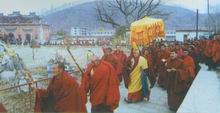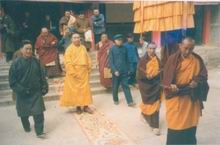The reincarnation
system for the Dalai Lama was introduced in the 16th century.
In the early years of the Qing Dynasty, the 5th Dalai Lama journeyed
to Beijing to pay homage to Emperor Shunzhi. The Qing emperor
granted him the honorific title of "the Dalai Lama, Overseer
of the Buddhist Faith on Earth Under the Great Benevolent Self-subsisting
Buddha of the Western Paradise.'' The title Dalai Lama was thus
established and is still in up today. The current Dalai Lama was
enthroned in the Potala Palace on February 22, 1940, during a
ceremony presided over by Wu Zhongxin, minister of the Commission
for Mongolian and Tibetan Affairs of the nationalist government
of the Republic of China (1911-49). The nationalist government
ordered that he be confirmed as the reincarnated soul boy of the
13th Dalai Lama without the requirement to carrying the established
method of drawing lot from the golden urn and that he instead
directly succeed as the 14th Dalai Lama.
The reincarnation system for the Bainqen Lama was introduced
in 1713 when the 5th Bainqen was granted the honorific title as
"Bainqen Erdeni," with Erdeni meaning "great treasure"
in Manchu. The 9th Bainqen Erdeni and the 13th Dalai Lama were
at odds during the period of the Republic of China, with the 9th
Bainqen Erdeni departing for China's hinterland. He later passed
away in Qinghai Province. The Tashilhungpo Monastery, the resident
monastery for the Bainqen Erdeni, located a boy by the name of
Gongbo Cidain. All signs pointed to the fact that he was indeed
the reincarnated soul boy of the 9th Bainqen Erdeni. Li Zongren,
the acting president of the Republic of China, issued a special
order instructing that the boy "be excuses from the lot-drawing
method and given the special permission to succeed as the 10th
Bainqen Erdeni." The grand enthronement ceremony held in
the Tar Monastery on August 10, 1949, was presided over by Guan
Jieyu, minister of the Commission for Mongolian and Tibean Affairs
of the nationalist government of the Republic of China.
The Gelug Sect of Tibetan Buddhism came to power in Tibet in
the 17th century and the Living Buddha reincarnation system became
a bone of contention with the upper class in Tibet. In 1793, as
part of an effort to turn the tide by overcoming drawbacks characteristic
of soul boys nominated from the same tribes, the Qing government
promulgated the 29-Article Ordinance for the More Efficient Governing
of Tibet. Article one of the Ordinances stipulates: In order to
ensure the Yellow Sect continues to flourish, the Grand Emperor
bestows it with a golden urn and ivory slips for use in confirming
the reincarnated soul boy of a deceased Living Buddha. For this
purpose, four major Buddhist Guardians will be summoned; the name's
of candidates, as well as their birth years, will be written on
the ivory slips in the three languages - Manchu, Han Chinese and
Tibetan; the ivory slips will be placed into the golden urn and
learned Living Buddhas will pray for seven days before various
Hotogtu Living Buddhas and High Commissioners stationed in Tibet
by the Central Government officially confirm the reincarnated
soul boy by drawing a lot from the golden urn in front of the
statue of Sakyamuni in the Jokhang Monastery.
The system of drawing lot from the golden urn thus perfected
the Living Buddha reincarnation system of Tibetan Buddhism. Following
the lot-drawing ceremony, the High Commissioners and leaders of
the soul boy search group were required to report the result to
the Central Government. The enthronement ceremony was held following
the approval of the Central Government.
The Qing court commissioned artisans to create two golden urns.
One golden urn, used to confirm reincarnations of the Dalai Lama
and the Bainqen Erdeni, is currently housed in the Potala Palace
in Lhasa. The other, used to confirm the reincarnations of Mongolian
and Tibetan Grand Living Buddhas and hotogtu Living Buddhas, is
housed in the Yonghegong Lamasery in Beijing.
|



